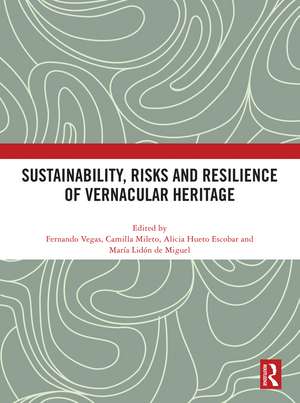Sustainability, Risks and Resilience of Vernacular Heritage
Editat de Fernando Vegas, Camilla Mileto, Alicia Hueto Escobar, María Lidón de Miguelen Limba Engleză Hardback – 21 iun 2024
The different examples of vernacular architecture studied in this book highlight the cultural wealth of this type of heritage, which has not only adapted to locally available resources and the needs of individual populations but has also successfully responded to the natural risks it encountered. As regards the types of risks analysed, the chapters focus on the impact of natural events on this type of heritage, proposing different methodologies for the analysis of vulnerability and any possible damage caused.
In general, the contributions included offer an interesting analysis of the behaviour of vernacular architecture in the face of natural hazards and the different scales or approaches that can be employed to cope with them. This book will be of particular interest to specialists and those interested in the fields of architecture, history, structures and risk management. It was originally published as a special issue of the International Journal of Architectural Heritage.
Preț: 986.91 lei
Preț vechi: 1404.21 lei
-30% Nou
Puncte Express: 1480
Preț estimativ în valută:
188.84€ • 196.70$ • 157.43£
188.84€ • 196.70$ • 157.43£
Carte tipărită la comandă
Livrare economică 28 martie-11 aprilie
Preluare comenzi: 021 569.72.76
Specificații
ISBN-13: 9781032756721
ISBN-10: 1032756721
Pagini: 152
Dimensiuni: 210 x 280 mm
Greutate: 0.45 kg
Ediția:1
Editura: Taylor & Francis
Colecția Routledge
Locul publicării:Oxford, United Kingdom
ISBN-10: 1032756721
Pagini: 152
Dimensiuni: 210 x 280 mm
Greutate: 0.45 kg
Ediția:1
Editura: Taylor & Francis
Colecția Routledge
Locul publicării:Oxford, United Kingdom
Public țintă
Postgraduate, Undergraduate Advanced, and Undergraduate CoreCuprins
Introduction: Sustainability, Risks and Resilience of Vernacular Architecture 1. Combining Structural and Non-structural Risk-reduction Measures to Improve Evacuation Safety in Historical Built Environments 2. A Multiscale Approach for the Seismic Vulnerability Assessment of Historical Centres in Masonry Building Aggregates: Cognitive Approach and Interdisciplinary Perspectives 3. Seismic Vulnerability Assessment of Historical Masonry Aggregate Buildings. The Case of Fes Medina in Morocco 4. Assessment of Vulnerability of Earthen Vernacular Architecture in the Iberian Peninsula to Natural Risks. Generation of an Analysis Tool 5. Minnan and Hakka Tulou. Functional, Typological and Construction Features of the Rammed Earth Dwellings of Fujian (China) 6. Anti-Seismic Retrofitting Techniques for Vernacular Adobe Buildings in Colombia: A Proposed Framework for Developing and Assessing Sustainable and Appropriate Interventions 7. Digital Survey and Structural Investigation on the Triumphal Arch of Caracalla in the Archaeological Site of Volubilis in Morocco: Retracing the Timeline of Collapses Occurred during the 18th Century Earthquake
Notă biografică
Fernando Vegas, PhD, and Camilla Mileto, PhD, are professors at the Architecture Faculty of the Universitat Politècnica de València (Spain) and members of the Architecture, Heritage and Management for Sustainable Development Research Centre PEGASO. Specialists in the restoration and conservation of vernacular architecture with decades of teaching, research and practical experience, recognised with multiple awards such as Europa Nostra, Domus or INTBAU Excellence Awards. They are responsible in Spain for the UNESCO Chair of Earthen Architecture, Constructive Cultures and Sustainable Development, as well as directors of the magazine Loggia and the research group.
Alicia Hueto Escobar, PhD, and María Lidón de Miguel, PhD, are architects and researchers at the Architecture, Heritage and Management for Sustainable Development Research Centre PEGASO at the Universitat Politècnica de València, Spain. Their research on vernacular architecture ranges from the study of construction techniques to their adaptation to current needs, risks, sustainability, development cooperation, etc.
Alicia Hueto Escobar, PhD, and María Lidón de Miguel, PhD, are architects and researchers at the Architecture, Heritage and Management for Sustainable Development Research Centre PEGASO at the Universitat Politècnica de València, Spain. Their research on vernacular architecture ranges from the study of construction techniques to their adaptation to current needs, risks, sustainability, development cooperation, etc.
Descriere
This book offers a variety of analyses, methodologies, and reflections on the behaviour of vernacular architecture in the face of natural hazards, with an emphasis on the strategies that can be used to cope with them. It was originally published as a special issue of the International Journal of Architectural Heritage.
